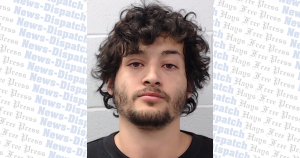By Moses Leos III
Steadily declining water levels forced the Barton Springs Edwards Aquifer Conservation District (BSEACD) Board of Directors to declare Stage 2 Alarm Drought status last week.
And, in the meantime, history was being made as the Edwards Aquifer Authority (EAA) out of San Antonio moved into the Stage 4 stage for the first time, forcing San Marcos to also move into Stage 4.
The decision by BSEACD caused Buda to enact Stage 2 Drought Restrictions on Tuesday.
Under Stage 2 Alarm Drought, the BSEACD requires all permit-holders to reduce monthly pumpage by 20 percent. Curtailment measures extend to Buda and Kyle, which are permitted to pump water from the Barton Springs portion of the Edwards Aquifer. It also calls for permit-holders to enact mandatory water conservation measures.
“Our bottom line for compliance is that [permit-holders] meet that curtailment goal of 20 percent,” BSEACD General Manager John Dupnik said.
To the south, the EAA has been in almost continuous drought Stage 3 restrictions since April 2011.
EAA’s Stage 4 was triggered when the 10-day average in the index well falls below 630 feet above mean sea level (msl). The average was 629.7 on Aug. 12. The historic low of this portion of the aquifer is 612 feet on Aug. 17, 1956.
The BSEACD drought trigger sites, the Lovelady Monitor well, fell below the Stage 2 threshold of 478.4 feet above mean sea level in mid-July. The district’s second drought trigger, the Barton Springs ten-day average discharge, is at its Stage 2 threshold of 38 cubic feet per second.
Mandatory drought restrictions were originally lifted on July 26 by BSEACD, due to both drought triggers meeting threshold requirements.
However, predicted July rainfall missed the recharge zone, leading to declining water levels and spring flow.
It’s part of a “unique year” the BSEACD had, according to Dupnik. The rains during the Oct. 31 rain event, along with rains in May, benefitted the aquifer. Dupnik said the events helped fill area creeks, which contributed to recharging the aquifer.
However, the slide toward drought status was renewed with the recent lack of rainfall.
“It’s been a cyclical roller coaster defined by the rainfall events and where it occurs,” Dupnik said. “It does speak to how localized these effects can be.”
The increase in the Alarm Drought status forces Buda to begin mandatory water restrictions.
Under Stage 2 in Buda, irrigation with sprinklers is limited to only two times per week, but only between midnight and 10 a.m., and 7 p.m. to midnight.
The city is also taking steps to meet curtailment measures, including modifying operations. That’s added to several water conservation measures in place, which include utilizing non-potable recycled effluent water to irrigate parks and medians.
While Buda enacts it’s first step in water contingency, Kyle will continue to maintain it’s current status.
Kyle has been under Stage 2 Drought Management Measures for roughly 18 months.
Jason Biemer, utility coordinator for the city of Kyle, said the city is able to meet the curtailment guidelines. He doesn’t anticipate recommending city staff to increase to Stage 3.
“Everything is staying the same right now,” Biemer said. “We will evaluate our drought status as it wears on. We will make adjustments accordingly.”
In San Marcos, Jan Klein, conservation coordinator, said Stage 4 does not have specific measures outlines.
“Instead of a new set of restrictions, we have decided to stay with the Stage 3 rules and increase our enforcement efforts,” Klein said.
BSEACD’s Dupnik said its drought declarations fall roughly on a six-month time frame. That’s dependent on weather conditions, which affects the timing of board meetings.
The continued lack of rainfall could accelerate the next declaration.
“We are holding out hopes the predictions for El Niño come true,” Dupnik said. “If that comes to pass, there’s a better than average chance for some fall and winter rainfall.”
Kyle Stage 2 Drought Management Measures
Watering schedule:
• Residential odd numbered addresses – Wednesday and/or Saturday
• Residential even-numbered addresses – Thursday and/or Sunday
• Commercial and Multi Family – Tuesday and/or Friday.
Irrigation
• Use of a hand held hose, or bucket at any time
• Irrigation with sprinkler, soaker hose or drip irrigation limited to 8 p.m. to 10 a.m. on designated day
• Automatic sprinklers only from midnight to 10 a.m. on designated day
Car washing
• Only on designated day from midnight to 10 a.m. and 7 p.m. to midnight.
• Must be done with handheld bucket or handheld hose equipped with a positive shutoff nozzle.
Prohibited items:
• Adding water to swimming or wading pools using automatic fill valve
• Charity car washes
• Washing sidewalks, driveways, parking areas, streets, patios, except to alleviate immediate safety hazard.
Buda Stage 2 Drought Restrictions
Watering schedule
• Odd numbered residential addresses – Wednesday and/or Saturday
• Even numbered residential addresses – Thursday and/or Sunday
• Commercial, mixed use and multifamily properties – Tuesday and/or Friday
Irrigation
• Use of sprinklers, hand held bucket, hand held hose, soaker hose or drip is only allowed on designated day only before 10 a.m. and after 7 p.m.
Charity car washing
• Prohibited unless occurring at a commercial car wash facility
Residential car washing
• Adhere to same watering schedule and permitted hours as irrigation. Must use hand held bucket or hand held hose with positive shut off
Swimming Pools
• Filling of new pools is prohibited, but make-up is allowed. Surface of pool shall be 25 percent covered when not in use
Prohibited items
• Non recirculating aesthetic water features
• Washing of impervious surfaces unless required for health reasons










